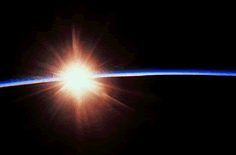 So what do you think, should I bother making a bluish atmosphere around planets, or not?
So what do you think, should I bother making a bluish atmosphere around planets, or not?
Planet atmosphere seen from space
In space games you often see a bluish atmosphere drawn around the earth (or other planets), but I''m wondering if it''s realistic to do so?
I''ve searched for some pictures with google, and the effect is hardly visible.
 So what do you think, should I bother making a bluish atmosphere around planets, or not?
So what do you think, should I bother making a bluish atmosphere around planets, or not?
 So what do you think, should I bother making a bluish atmosphere around planets, or not?
So what do you think, should I bother making a bluish atmosphere around planets, or not?
I think you should because you can add some clouds like this and you can make them animated (rotating around the planet).
Make another sphere (greater radius, map with cloud texture and give it a blueish color) which you blend over the planet-sphere.
The only problem is the blending and that from some angles you will see the blended sphere saturating the color.
[ My Site ]
All your source are belong to us
/*ilici*/
Make another sphere (greater radius, map with cloud texture and give it a blueish color) which you blend over the planet-sphere.
The only problem is the blending and that from some angles you will see the blended sphere saturating the color.
[ My Site ]
All your source are belong to us
/*ilici*/
Like that ?

It''s mostly visible when lit at a grazing angle.
[ Start Here ! | How To Ask Smart Questions | Recommended C++ Books | C++ FAQ Lite | Function Ptrs | CppTips Archive ]
[ Header Files | File Format Docs | LNK2001 | C++ STL Doc | STLPort | Free C++ IDE | Boost C++ Lib | MSVC6 Lib Fixes ]

It''s mostly visible when lit at a grazing angle.
[ Start Here ! | How To Ask Smart Questions | Recommended C++ Books | C++ FAQ Lite | Function Ptrs | CppTips Archive ]
[ Header Files | File Format Docs | LNK2001 | C++ STL Doc | STLPort | Free C++ IDE | Boost C++ Lib | MSVC6 Lib Fixes ]
just some quick thoughts regarding Ilici's suggestion:
u could use a fresnel term in a vertex or fragment program to set your atmosphere color/opacity, but that won't work in the case of your last screenshot :/
unless you also have an alpha value set according to the amount of sunlight received, witch can be precomputed and not changed even if your planet rotates (if it simply rotates around the sun, the amount of sunlight received by the planet won't change, if the planet also rotates around itself, just rotate the inner sphere (planet), not the outer sphere (athmosphere))
that might not work at all or be too computationally expensive, I don't know.. just some ideas
[edited by - sBibi on November 9, 2003 10:09:59 AM]
u could use a fresnel term in a vertex or fragment program to set your atmosphere color/opacity, but that won't work in the case of your last screenshot :/
unless you also have an alpha value set according to the amount of sunlight received, witch can be precomputed and not changed even if your planet rotates (if it simply rotates around the sun, the amount of sunlight received by the planet won't change, if the planet also rotates around itself, just rotate the inner sphere (planet), not the outer sphere (athmosphere))
that might not work at all or be too computationally expensive, I don't know.. just some ideas
[edited by - sBibi on November 9, 2003 10:09:59 AM]
quote:Original post by Fruny
Like that ?
It''s mostly visible when lit at a grazing angle.
[ Start Here ! | How To Ask Smart Questions | Recommended C++ Books | C++ FAQ Lite | Function Ptrs | CppTips Archive ]
[ Header Files | File Format Docs | LNK2001 | C++ STL Doc | STLPort | Free C++ IDE | Boost C++ Lib | MSVC6 Lib Fixes ]
i dont think that would be too hard to do: you have to compute the visibility of each vertex of the atmosphere spehre as it is shadowed by the planet''s sphere - this is quite easy. then estimate the amount of light at each vertex of the atmosphere by raytracing. calculate the sunflare''s visibility using the planet as an occluder.
[ My Site ]
All your source are belong to us
/*ilici*/
quote:
It''s mostly visible when lit at a grazing angle.
or when close to or inside the upper athmosphere.
quote:Original post by Eelcoquote:
It''s mostly visible when lit at a grazing angle.
or when close to or inside the upper athmosphere.
Or when on the planet''s surface.
James Simmons
MindEngine Development
http://medev.sourceforge.net
quote:
Or when on the planet''s surface.
well not quite.. you dont see the transition between air ans space then.
This topic is closed to new replies.
Advertisement
Popular Topics
Advertisement





